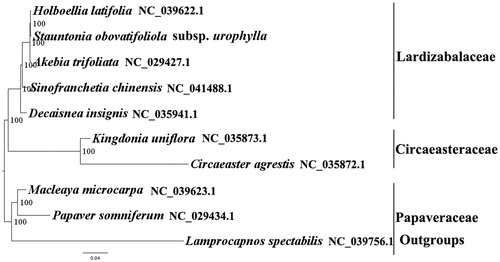Abstract
Stauntonia obovatifoliola subsp. urophylla belongs to Lardizabalaceae. It is woody vine, with fine lines on its stems, branches, and petioles. In China, they are mainly distributed in Fujian, Guangdong, Guangxi, Jiangxi, Hunan, and Zhejiang. Here, we report and characterize the complete plastid genome sequence of S. obovatifoliola subsp. urophylla in an effort to provide genomic resources useful for promoting its systematics research. The complete plastome of S. obovatifoliola subsp. urophylla is 158,944 bp in length, including two Inverted Repeat (IR) regions of 26,284 bp, a Large Single-Copy (LSC) region of 87,306 bp and a Small Single-Copy (SSC) region of 19,070 bp. The plastome contains 115 genes, consisting of 80 unique protein-coding genes, 31 unique tRNA genes, and four unique rRNA genes. The overall A/T content in the plastome of S. obovatifoliola subsp. urophylla is 61.40%. The complete plastome sequence of S. obovatifoliola subsp. urophylla will provide a useful resource for the conservation genetics of the species as well as for the phylogenetic studies of the genus Stauntonia.
Introduction
Stauntonia obovatifoliola subsp. urophylla (Hand.-Mazz.) H.N. Qin belongs to Lardizabalaceae. It is woody vine, with fine lines on its stems, branches, and petioles. In China, it is mainly distributed in Fujian, Guangdong, Guangxi, Jiangxi, Hunan, and Zhejiang (Dezhao and Shimizu Citation2001). Consequently, the genetic and genomic information is urgently needed to promote its systematics research. Here, we report and characterize the complete plastome of S. obovatifoliola subsp. urophylla (GenBank accession number: MK799642, this study). This is the first report of a complete plastome for the genus Stauntonia.
In this study, S. obovatifoliola subsp. urophylla was sampled from Hesheng Village, Wenzhou City, Zhejiang Province of China (28.374°N, 120.840°E). The voucher specimens (Wang et al., B202) were deposited in the Herbarium of the Institute of Tropical Agriculture and Forestry (HUTB), Hainan University, Haikou, China.
The experiment procedure is as reported in Zhu et al. (Citation2018). Around 6 Gb clean data were assembled against the plastome of Decaisnea insignis (NC_035941.1) (Li et al. Citation2017) using MITObim v1.8 (Hahn et al. Citation2013). The plastome was annotated using Geneious R8.0.2 (Biomatters Ltd., Auckland, New Zealand) against the plastome of D. insignis (NC_035941.1). The annotation was corrected with DOGMA (Wyman et al. Citation2004).
The plastome of S. obovatifoliola subsp. urophylla was found to possess a total length 158,944 bp. It has typical quadripartite structure of angiosperms, containing two Inverted Repeats (IRs) of 26,284 bp, a Large Single-Copy (LSC) region of 87,306 bp, a Small Single-Copy (SSC) region of 19,070 bp. The plastome contains 115 genes, consisting of 80 unique protein-coding genes (six of which are duplicated in the IR), 31 unique tRNA genes (seven of which are duplicated in the IR), and four unique rRNA genes. Among these genes, 13 genes possessed a single intron and three genes (ycf3, clpP, and rps12) had two introns. The gene rps12 was found to be trans-spliced, as is typical of angiosperms. The overall A/T content in the plastome of S. obovatifoliola subsp. urophylla is 61.40%, which the corresponding value of the LSC, SSC, and IR region were 62.9%, 66.4%, and 57%, respectively.
We used RAxML (Stamatakis Citation2006) with 1000 bootstraps under the GTRGAMMAI substitution model to reconstruct a maximum-likelihood (ML) phylogeny of four published complete plastomes of Lardizabalaceae and two published complete plastomes of Circaeasteraceae, using three published complete plastomes of Papaveraceae as outgroups. The phylogenetic analysis indicated that S. obovatifoliola subsp. urophylla was close to Holboellia latifolia in this study (). Most nodes in the plastome ML trees were strongly supported. The complete plastome sequence of S. obovatifoliola subsp. urophylla will provide a useful resource for the conservation genetics of this species as well as for the phylogenetic studies of the genus Stauntonia.
Figure 1. The best ML phylogeny recovered from 10 complete plastome sequences by RAxML. Accession numbers: Stauntonia obovatifoliola subsp. urophylla (MK799642, this study), Holboellia latifolia NC_039622.1, Akebia trifoliata NC_029427.1, Sinofranchetia chinensis NC_041488.1, Decaisnea insignis NC_035941.1, Kingdonia uniflora NC_035873.1, Circaeaster agrestis NC_035872.1, outgroups: Papaver somniferum NC_029434.1, Lamprocapnos spectabilis NC_039756.1, and Macleaya microcarpa NC_039623.1.

Disclosure statement
No potential conflict of interest was reported by the authors.
Additional information
Funding
References
- Dezhao C, Shimizu T. 2001. Flora of China, Vol. 6. Beijing: Science Press; p. 440–454.
- Hahn C, Bachmann L, Chevreux B. 2013. Reconstructing mitochondrial genomes directly from genomic next-generation sequencing reads-a baiting and iterative mapping approach. Nucleic Acids Res. 41:e129.
- Li B, Lin F, Huang P, Guo W, Zheng Y. 2017. Complete chloroplast genome sequence of Decaisnea insignis: genome organization, genomic resources and comparative analysis. Sci Rep. 7:10073.
- Stamatakis A. 2006. RAxML-VI-HPC: maximum likelihood-based phylogenetic analyses with thousands of taxa and mixed models. Bioinformatics. 22:2688–2690.
- Wyman SK, Jansen RK, Boore JL. 2004. Automatic annotation of organellar genomes with DOGMA. Bioinformatics. 20:3252–3255.
- Zhu Z-X, Mu W-X, Wang J-H, Zhang J-R, Zhao K-K, Ross Friedman C, Wang H-F. 2018. Complete plastome sequence of Dracaena cambodiana (Asparagaceae): a species considered “Vulnerable” in Southeast Asia. Mitochondrial DNA B. 3:620–621.
